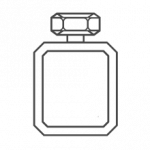About Diamonds

Diamonds have been a source of fascination for centuries. They are the hardest, the most imperishable, and the most brilliant of all precious stones. The word “diamond” comes from the Greek word Adamas, meaning “unconquerable”.
A diamond is a transparent gem made of carbon, one of the earth’s most common elements. The formation of diamonds began very early in the earth’s history, when the condensation of solid matter into a sphere caused the centre of the planet to become subjected to incredible extremes of temperatures and pressure.
Many people expect a diamond to be unbreakable. This is not true. A diamond’s crystal structure has “hard” and “soft” directions. A blow of sufficient force, in a very exact direction, can crack, chip, split or even shatter a diamond.
Types Of Diamonds
Fancy Coloured Diamonds
The 4C’s of colour, cut, clarity and carat weight apply to coloured diamonds just as they do to colourless diamonds except the intensity of colour, not lack of it, plays a greater part in the valuation.
Pink Diamonds
For years the white diamond was considered the world’s most beautiful diamond, until the discovery of the Argyle mine heralded the arrival of the Argyle pink diamond. Never before had pink diamonds displaying such intense shades of colour been seen. The pink diamonds of India, Brazil and Africa were characteristically light in colour and paled even further when placed beside the intensely pink Argyle diamonds. The natural colour diamonds have in fact been around as long as the classical whites but in much smaller quantities and never in great demand. The Argyle Pink Diamond comes in shades ranging from delicate pastel rose to robust raspberry and full-blooded purple-reds. The prices per carat are determined by the intensity of colour.
White Diamonds
White diamonds are produced by mines all over the world in a wide variety of shapes and sizes. The white diamonds recovered from the Argyle mine are particularly brilliant and of high quality. Once a year, Argyle Diamonds issues a special release of outstanding pink diamonds that are sold by special bids in the international and invitation-only, Pink Diamond Tender.
White diamonds with secondary pink colour
The Argyle mine also produced white diamonds with secondary pink colour that command a higher price per carat. In an effect similar to that described of pink champagne diamonds, the white diamond will display slight to bold flashes of pink when viewed from the top. A higher price is commanded for pink secondary colour depending on its depth and strength, because pink is one of the rarest colours found in diamonds. Argyle Diamonds created the following scale specifically for champagne diamonds. The diamonds are graded on a C1-C7 colour scale. C1 and C2 represent light champagne, C3 and C4 medium champagne, and C5 and C6 dark champagne. The fancy cognac diamond is graded C7.
Champagne Diamonds
Champagne diamonds are naturally coloured diamonds that are produced in a wide range of colours from light straw to rich cognac.
Pink Champagne Diamonds
Attractive champagne diamonds with secondary pink colour are also available and command a higher price per carat than champagne diamonds. These stones display slight to bold flashes of pink in their fire. Argyle Pink Champagne Diamonds are available in a range of shades, from light pink champagne to medium and dark pink champagne. As pink is one of the rarest colours found in diamonds, even secondary colours demand a higher price depending on depth and strength of colour.
CARING FOR YOUR DIAMONDS

It is better not to wear diamond jewellery when doing rough work or the dishes. Despite the durability of a diamond, it can be chipped by a hard blow along its grain.

Take care when doing the housework, not to let diamond jewellery come into contact with chlorine bleach, as it won’t harm the diamond but can pit or discolour the mounting.

When placing diamond jewellery in a jewellery case, be sure to wrap them individually as they can easily scratch each other as well as other gem jewellery. Be sure to take all types of precious mounted jewellery to a jeweller at least once a year to check for loose settings and signs of wear.

